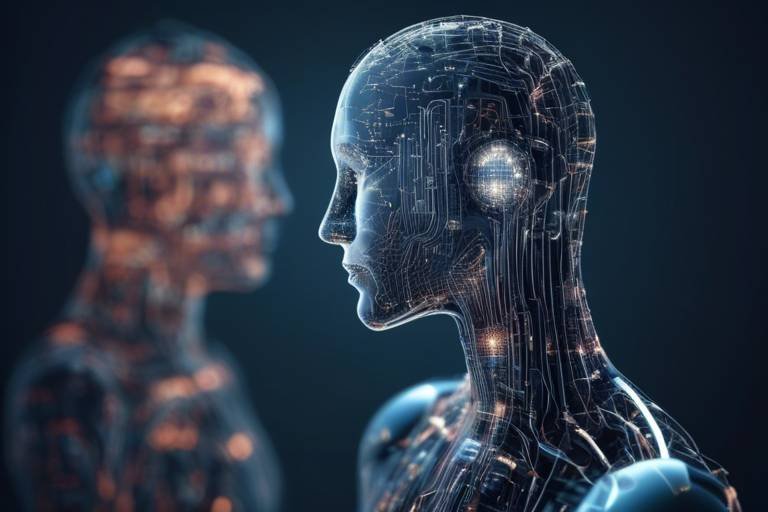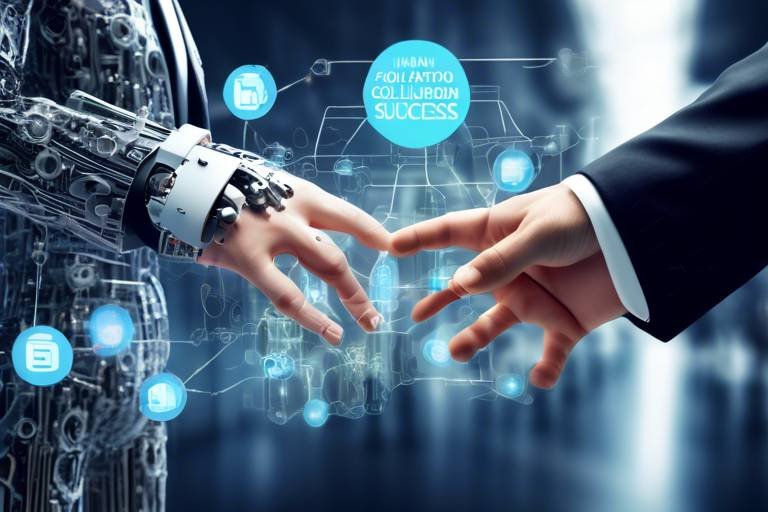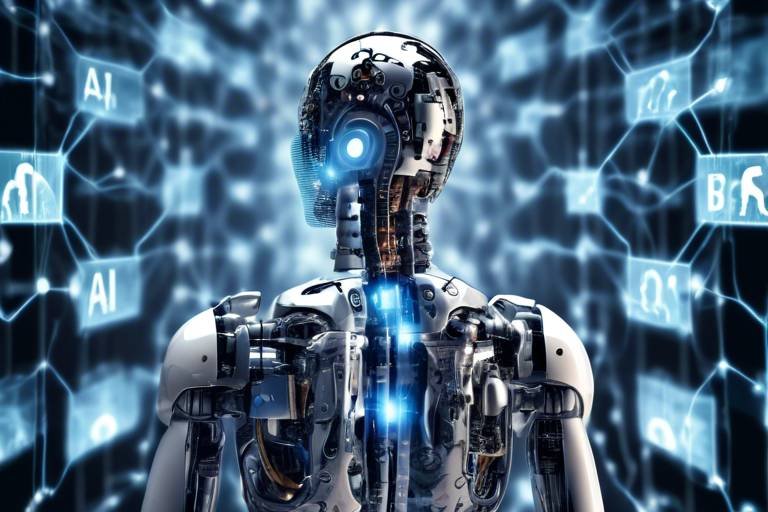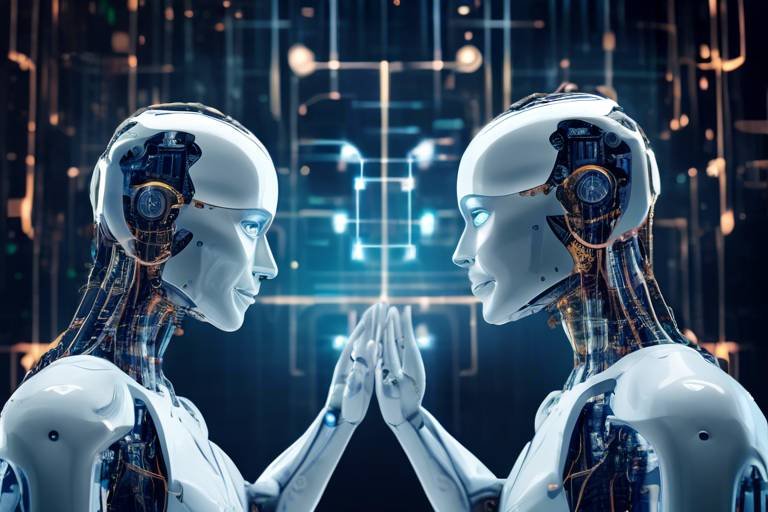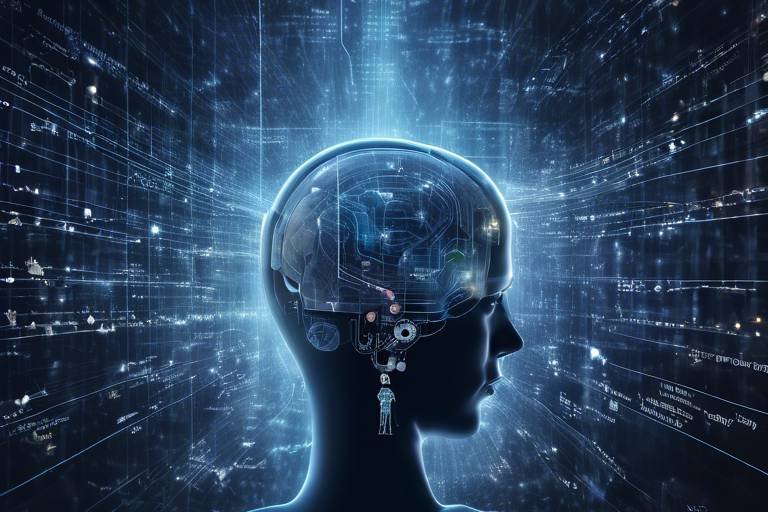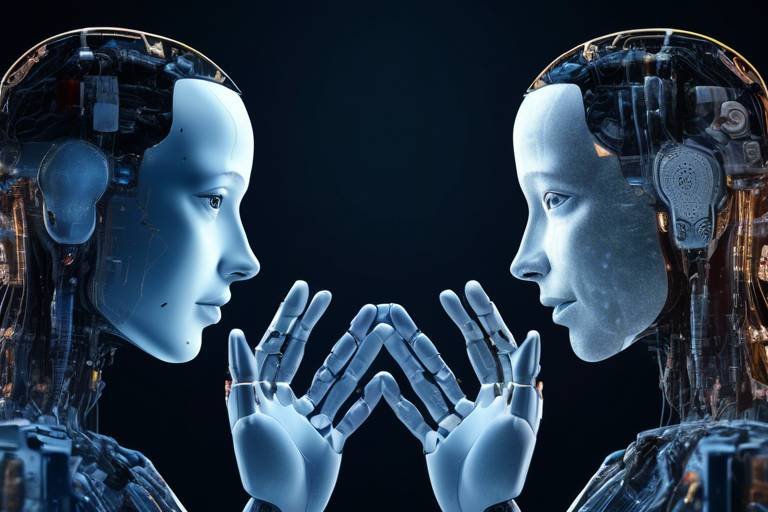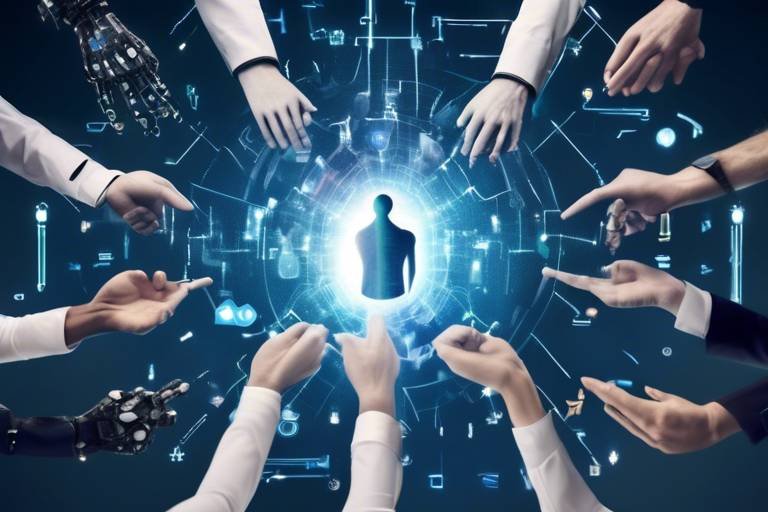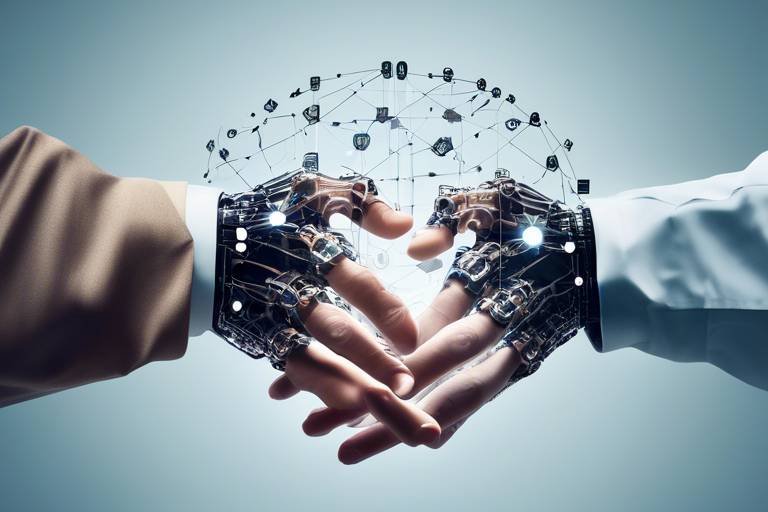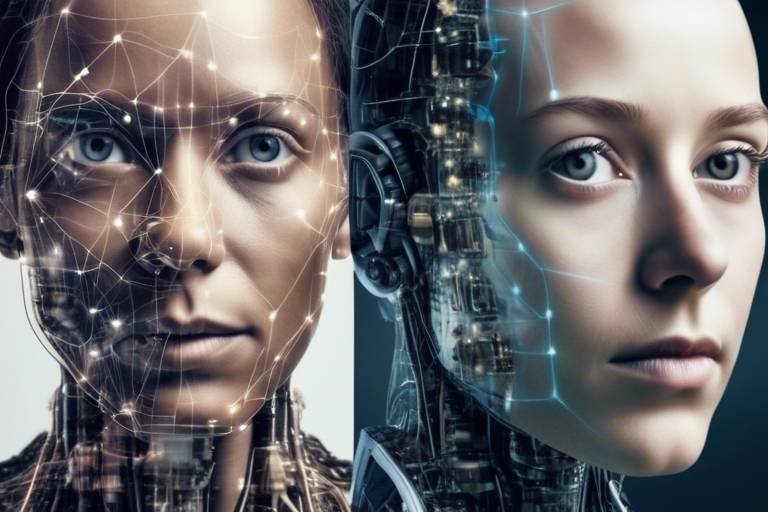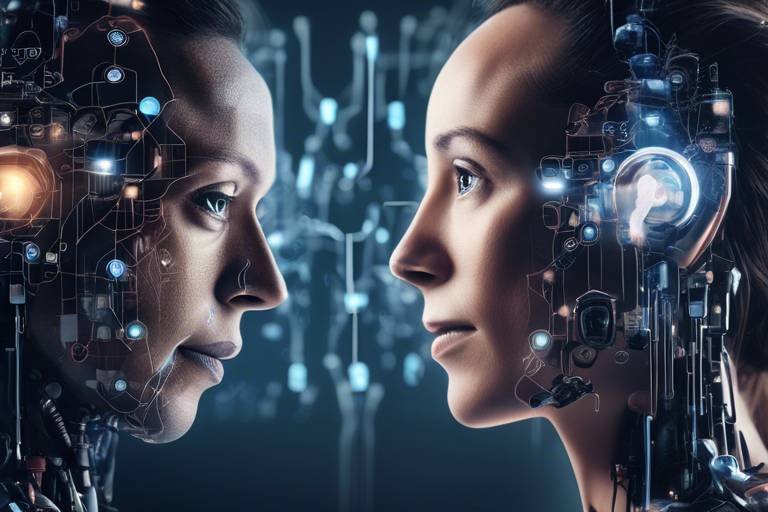Threading Together AI and Human Intelligence for Collaboration
In today's fast-paced world, the convergence of artificial intelligence (AI) and human intelligence is not just a futuristic concept; it's a reality that is reshaping how we work, create, and innovate. Imagine a world where machines and humans collaborate seamlessly, each enhancing the other's capabilities. This synergy is not merely about replacing human effort; it's about amplifying it. With AI taking on repetitive tasks, humans can focus on what truly matters: creativity, strategic thinking, and emotional intelligence. Together, they form a powerful duo, capable of tackling complex challenges that neither could face alone.
The potential for this collaboration spans various sectors, from healthcare to finance, education to entertainment. For instance, in healthcare, AI can analyze vast datasets to identify patterns and suggest treatment options, while doctors apply their expertise and empathy to make final decisions. This partnership not only improves patient outcomes but also enhances the overall efficiency of healthcare systems. In finance, AI algorithms can predict market trends, but it’s the financial analysts who interpret these insights, adding a layer of human judgment that is crucial for sound investment strategies. The possibilities are as exciting as they are endless!
However, this collaboration is not without its challenges. As we integrate AI into our daily lives, we must also consider the ethical implications and ensure that human oversight remains a cornerstone of AI development. After all, while machines can process information at lightning speed, they lack the moral compass that guides human decisions. As we delve deeper into this fascinating topic, we’ll explore how to harness the strengths of both AI and human intelligence, ensuring that their collaboration leads to enhanced productivity, creativity, and decision-making.
Understanding how AI tools can augment human skills and competencies is essential for unlocking their full potential. AI is not just a tool; it's a partner that can help us achieve more than we ever thought possible. For example, consider the field of marketing. AI-driven analytics can sift through mountains of data, identifying trends and consumer behaviors that would take humans weeks to uncover. This allows marketers to craft personalized campaigns that resonate with their audience, leading to higher engagement and conversion rates. By automating mundane tasks, AI frees up valuable time for marketers to brainstorm innovative strategies and connect with their customers on a more personal level.
Moreover, AI can facilitate learning and development in the workplace. With personalized learning platforms powered by AI, employees can receive tailored training programs that suit their unique learning styles and paces. This not only enhances individual performance but also contributes to a more skilled workforce overall. As organizations embrace AI, they must also cultivate a culture that encourages continuous learning and adaptation, ensuring that human intelligence evolves alongside technological advancements.
As we explore the intersection of AI and human intelligence, it’s crucial to recognize the role of human oversight in the development of ethical AI. Humans are responsible for setting the parameters of machine learning, ensuring that ethical considerations are woven into every aspect of AI technology. Without this oversight, we risk creating systems that perpetuate biases and inequalities, leading to outcomes that could be detrimental to society.
Bias in AI algorithms often stems from the data they are trained on. If the data reflects historical inequalities or prejudices, the AI will likely reproduce those biases in its decision-making processes. This is where human intelligence plays a vital role. By actively engaging in the development and training of AI systems, humans can identify potential biases and take steps to mitigate them, ensuring that AI serves as a force for good rather than a perpetuator of injustice.
Organizations can adopt several effective strategies to minimize bias in AI systems:
- Data Diversity: Ensure that training data is representative of diverse populations to avoid skewed outcomes.
- Regular Audits: Conduct frequent assessments of AI systems to identify and rectify biases.
- Human-in-the-loop Approaches: Incorporate human judgment in critical decision-making processes to provide context and ethical considerations.
Several companies have successfully tackled bias in their AI systems. For example, a leading tech firm implemented a comprehensive audit of its hiring algorithms, discovering that certain demographic groups were being unfairly screened out. By adjusting the algorithm and ensuring a more balanced dataset, they not only improved their hiring practices but also fostered a more inclusive workplace. Such case studies highlight the importance of vigilance and adaptability in the AI landscape.
When we analyze the strengths of AI and human intelligence, it becomes clear that their collaboration is not just beneficial; it’s essential. AI excels at processing vast amounts of data quickly and accurately, while humans bring creativity, empathy, and ethical reasoning to the table. Together, they can tackle complex problems that require both analytical rigor and human insight.
To facilitate effective collaboration, various frameworks and models have emerged that emphasize the partnership between AI technologies and human teams. These models encourage a culture of collaboration, where AI acts as a supportive partner rather than a replacement. By fostering an environment where both AI and humans can thrive, organizations can unlock unprecedented levels of productivity and innovation.
AI can enhance teamwork and communication among human workers by automating routine tasks and providing valuable insights. For instance, in project management, AI tools can track progress, allocate resources, and even predict potential bottlenecks. This allows team members to focus on higher-level strategic planning and creative problem-solving, leading to more effective collaboration.
Finally, the principles of designing AI systems that prioritize human needs and experiences cannot be overlooked. By adopting a human-centered approach, organizations can ensure that AI tools are intuitive, accessible, and aligned with the goals of their users. This fosters seamless integration and collaboration in daily tasks, making the partnership between AI and humans not only effective but also enjoyable.
Q1: How does AI enhance human productivity?
AI enhances human productivity by automating repetitive tasks, providing data-driven insights, and enabling faster decision-making, allowing individuals to focus on more strategic and creative endeavors.
Q2: What are the ethical considerations in AI development?
Ethical considerations in AI development include ensuring fairness, transparency, accountability, and the minimization of bias in AI systems, which requires ongoing human oversight.
Q3: Can AI replace human jobs?
While AI can automate certain tasks, it is more likely to augment human jobs rather than replace them, enabling workers to engage in more meaningful and creative work.
Q4: How can organizations reduce bias in AI systems?
Organizations can reduce bias by ensuring diverse training data, conducting regular audits, and incorporating human judgment in decision-making processes.

The Role of AI in Enhancing Human Capabilities
Artificial Intelligence (AI) is not just a buzzword; it's a powerful tool that can transform the way we work and live. Imagine having a personal assistant that never sleeps, constantly learning and adapting to your needs. That's the essence of AI—augmenting our abilities in ways we never thought possible. From automating mundane tasks to providing insights that drive strategic decisions, AI enhances human capabilities across various sectors. In industries like healthcare, finance, and education, AI is paving the way for unprecedented advancements.
One of the most significant impacts of AI is its ability to process vast amounts of data quickly and accurately. For instance, in the medical field, AI algorithms can analyze patient data and identify potential health risks faster than any human doctor could. This not only improves patient outcomes but also allows healthcare professionals to focus on what they do best: caring for patients. Similarly, in finance, AI can detect fraudulent activities in real-time, providing a level of security that enhances trust and efficiency.
Moreover, AI can be a game-changer in enhancing creativity. By leveraging machine learning algorithms, artists and designers can explore new creative avenues they might not have considered. For example, AI tools can analyze existing artworks and suggest innovative styles or techniques, pushing the boundaries of human creativity. This partnership between AI and human artists illustrates how technology can serve as a catalyst for innovation.
In addition to creativity and efficiency, AI also plays a crucial role in decision-making. By providing data-driven insights, AI helps leaders make informed choices that can propel their organizations forward. For instance, in marketing, AI can analyze customer behaviors and preferences, allowing companies to tailor their strategies accordingly. This not only enhances customer satisfaction but also drives sales and profitability.
However, it's essential to recognize that AI is not here to replace humans; rather, it is designed to complement our skills. The most successful implementations of AI are those that integrate human expertise with machine efficiency. This synergy creates a workforce that is more productive, innovative, and adaptable to changing circumstances.
To illustrate the impact of AI on enhancing human capabilities, consider the following table that outlines various sectors and the specific ways AI contributes:
| Sector | AI Contribution |
|---|---|
| Healthcare | Predictive analytics for patient outcomes |
| Finance | Fraud detection and risk assessment |
| Education | Personalized learning experiences |
| Marketing | Customer behavior analysis and targeting |
In conclusion, the role of AI in enhancing human capabilities is profound and multifaceted. By automating repetitive tasks, providing insights for better decision-making, and fostering creativity, AI is enabling humans to reach new heights. The key is to embrace this technology as a partner, allowing it to elevate our capabilities while we retain the human touch that makes our work meaningful.

Human Intelligence: The Foundation of Ethical AI
In the rapidly evolving world of artificial intelligence, where algorithms can analyze vast amounts of data and make decisions at lightning speed, it's crucial to remember that human intelligence serves as the backbone of ethical AI development. While machines can process information and identify patterns, they lack the nuanced understanding of morality, context, and the human experience. This is where we, as humans, come into play. Our ability to empathize, reason, and consider ethical implications is essential in shaping AI technologies that are not only efficient but also responsible.
At the heart of ethical AI is the principle of accountability. Who is responsible when an AI system makes a mistake? This question highlights the necessity for human oversight in AI development. Without human intervention, AI systems could perpetuate biases or make decisions that may harm individuals or communities. Therefore, it is vital to establish frameworks that ensure human judgment is included in the decision-making processes of AI systems. This includes creating guidelines that promote transparency, fairness, and accountability in AI applications.
Moreover, the integration of ethical considerations into AI development is not just a technical challenge; it’s a cultural one. Organizations must foster an environment where ethical discussions are encouraged. This can be achieved through:
- Training programs that focus on ethical AI practices.
- Interdisciplinary teams that include ethicists, sociologists, and technologists working together.
- Establishing clear policies that prioritize ethical considerations in AI projects.
As we delve deeper into the complexities of AI, we must also recognize the importance of diversity in AI development teams. Diverse perspectives can help identify potential ethical pitfalls and biases in AI systems before they become problematic. By bringing together individuals from various backgrounds, we can create AI technologies that reflect a broader range of human experiences and values, ultimately leading to more ethical outcomes.
In summary, while AI has the potential to revolutionize industries and improve our lives, it is our human intelligence that lays the groundwork for ethical AI. By prioritizing accountability, fostering ethical discussions, and embracing diversity, we can ensure that AI technologies not only serve their intended purposes but also align with our collective values and ethics.
- What is ethical AI? Ethical AI refers to the development and implementation of artificial intelligence technologies that prioritize fairness, accountability, and transparency.
- Why is human oversight important in AI? Human oversight is crucial to prevent biases and unethical decisions that AI systems may make without understanding the broader context or moral implications.
- How can organizations promote ethical AI? Organizations can promote ethical AI by providing training, forming interdisciplinary teams, and establishing clear ethical guidelines for AI development.

Understanding Bias in AI Systems
In today's digital landscape, the integration of artificial intelligence (AI) into various sectors is undeniable. However, with great power comes great responsibility, and one of the most pressing issues facing AI today is bias. Bias in AI systems can stem from numerous sources, including the data used to train these models and the algorithms that process this data. Understanding these biases is crucial if we want to develop AI that is not only effective but also equitable.
At its core, bias in AI refers to the tendency of an algorithm to produce results that are systematically prejudiced due to erroneous assumptions in the machine learning process. This can manifest in several ways, such as discrimination against certain demographic groups or the reinforcement of stereotypes. For instance, if an AI system is trained on historical data that reflects societal biases, it may perpetuate those biases in its predictions or decisions. This is akin to teaching a child using a flawed textbook; the child will adopt the errors as truth unless corrected.
Moreover, the implications of biased AI are far-reaching. Consider a hiring algorithm that favors candidates from specific backgrounds while overlooking equally qualified individuals from underrepresented groups. This not only undermines the principles of fairness and equality but can also stifle innovation and diversity in the workplace. Therefore, it is essential for organizations to recognize and address these biases actively.
To tackle bias effectively, we need to engage in a multi-faceted approach that includes:
- Data Scrutiny: Ensuring the data used for training AI models is representative and free from historical biases.
- Algorithmic Transparency: Developing algorithms in a way that allows for scrutiny and understanding of how decisions are made.
- Human Oversight: Incorporating human judgment in the decision-making processes to catch and correct biased outcomes.
By understanding bias in AI systems, we can take significant steps toward creating more inclusive and fair AI technologies. The journey to mitigate bias is ongoing, and it requires a commitment from all stakeholders involved in AI development—from data scientists to policymakers. Only through collective efforts can we hope to harness the true potential of AI while ensuring it serves humanity as a whole.
- What is bias in AI? Bias in AI refers to systematic errors in algorithms that lead to unfair outcomes, often due to flawed training data or assumptions.
- How can bias in AI be mitigated? Strategies include using diverse datasets, ensuring algorithm transparency, and incorporating human oversight.
- Why is understanding bias important? Understanding bias is crucial to developing AI that is fair, equitable, and beneficial for all users.

Strategies for Reducing Bias
In the rapidly evolving landscape of artificial intelligence, addressing bias is not just a technical challenge but a moral imperative. Organizations must adopt comprehensive strategies to reduce bias in AI systems, ensuring that these technologies serve all users equitably. One of the first steps in this journey is to implement a robust framework for data collection. This means being deliberate about the diversity of the data sets used to train AI models. If the data is skewed or unrepresentative, the AI will inevitably reflect those biases. Thus, organizations should strive to gather data that encompasses a broad spectrum of demographics, including age, gender, ethnicity, and socio-economic backgrounds.
Another effective strategy is to engage in regular audits of AI algorithms. By routinely examining the outputs of AI systems, organizations can identify and address biases that may have been overlooked during the initial development stages. This proactive approach not only helps in refining the algorithms but also fosters a culture of accountability. For instance, companies can establish an internal team dedicated to monitoring AI performance and ensuring that it aligns with ethical standards.
Moreover, collaboration with diverse teams during the development phase is crucial. When developers come from varied backgrounds, they bring unique perspectives that can highlight potential biases that a homogenous team might miss. This diversity can extend beyond just race and gender to include different educational backgrounds, life experiences, and professional expertise. By incorporating a wide range of viewpoints, organizations can create AI systems that are more reflective of the real world.
In addition to these strategies, organizations should prioritize transparency in their AI processes. This involves documenting how AI systems are developed, the data used, and the decision-making processes involved. By making this information accessible, stakeholders can better understand the workings of these technologies and hold organizations accountable for their outcomes. Transparency not only builds trust with users but also encourages a more ethical approach to AI development.
Lastly, it's essential to foster a culture of continuous learning and adaptation. AI is not a set-it-and-forget-it solution; it requires ongoing evaluation and refinement. Organizations should be open to feedback from users and stakeholders, using this input to make necessary adjustments. This iterative process ensures that AI systems evolve alongside societal norms and values, reducing the risk of perpetuating outdated biases.
By implementing these strategies—focused data collection, regular audits, diverse teams, transparency, and a commitment to continuous improvement—organizations can significantly mitigate bias in AI systems. This not only enhances the reliability of AI outcomes but also promotes a fairer and more inclusive technological landscape.
- What is bias in AI systems? Bias in AI refers to systematic favoritism or discrimination in algorithmic outcomes, often stemming from biased training data or flawed algorithms.
- How can organizations ensure data diversity? Organizations can ensure data diversity by actively sourcing data from various demographics and continuously updating their datasets to reflect changes in society.
- Why is transparency important in AI development? Transparency is crucial as it builds trust, allows for scrutiny, and ensures accountability in AI decision-making processes.
- What role does team diversity play in reducing bias? Diverse teams bring multiple perspectives that can identify and challenge biases, leading to more equitable AI systems.

Case Studies of Successful Bias Mitigation
In recent years, numerous organizations have taken significant strides towards mitigating bias in their AI systems, showcasing innovative approaches that not only enhance fairness but also improve overall outcomes. One prominent example is IBM's Watson, which has implemented a rigorous bias detection mechanism in its AI models. By employing diverse datasets and continuously monitoring algorithm outputs, IBM has been able to identify and rectify biases that could skew results. This proactive approach ensures that the AI’s recommendations are more equitable and reflective of a broader demographic.
Another compelling case is that of Google, which has developed the Inclusive Images project. This initiative aims to address bias in image recognition algorithms by utilizing a more diverse set of training images. By actively engaging with communities and incorporating feedback, Google has significantly improved the accuracy of its image classification systems, especially for underrepresented groups. This not only enhances the technology but also fosters a sense of trust among users, demonstrating that technology can indeed be inclusive.
Moreover, Microsoft has made waves with its Fairness Flow tool, which allows developers to analyze their AI models for potential biases before deployment. This tool provides developers with insights into how their models may perform across different demographic groups, enabling them to make necessary adjustments. By integrating such tools into their development processes, Microsoft is setting a standard for responsible AI practices that prioritize fairness from the ground up.
To further illustrate the impact of these strategies, consider the following table that summarizes key initiatives from these organizations:
| Company | Initiative | Focus Area | Outcome |
|---|---|---|---|
| IBM | Watson Bias Detection | Algorithm Monitoring | Enhanced fairness in recommendations |
| Inclusive Images | Diverse Training Data | Improved image recognition accuracy | |
| Microsoft | Fairness Flow | Model Analysis | Proactive bias identification |
These case studies exemplify how organizations can successfully address bias in AI systems. By prioritizing diversity in training data, employing bias detection tools, and actively engaging with affected communities, companies not only enhance their AI technologies but also contribute to a more equitable digital landscape. The journey towards bias mitigation is ongoing, but these examples provide a roadmap for other organizations looking to follow suit.
- What is bias in AI? Bias in AI refers to the systematic favoritism or discrimination that can occur when algorithms are trained on skewed data, leading to unfair outcomes.
- How can organizations mitigate bias in AI? Organizations can mitigate bias by using diverse datasets, implementing bias detection tools, and engaging with communities to gather feedback.
- Why is it important to address bias in AI? Addressing bias is crucial to ensure fairness, build trust with users, and prevent perpetuating existing inequalities in society.
- Can AI ever be completely unbiased? While it may be challenging to achieve complete impartiality, continuous efforts in improving data quality and algorithm design can significantly reduce bias.

The Complementary Strengths of AI and Human Intelligence
In today's rapidly evolving technological landscape, the synergy between artificial intelligence (AI) and human intelligence is not just a concept; it's a necessity. Think of AI as the turbocharger for human capabilities. While humans bring creativity, emotional intelligence, and ethical reasoning to the table, AI excels in processing vast amounts of data and performing repetitive tasks with precision. This partnership can lead to enhanced problem-solving and innovation, making it vital for various industries.
Imagine a scenario where a team of doctors is diagnosing a rare disease. Here, human doctors rely on their experience, intuition, and interpersonal skills to understand a patient's condition, while AI algorithms can analyze thousands of medical records and research papers in seconds to identify potential diagnoses. This collaboration not only speeds up the decision-making process but also improves the accuracy of the outcomes. The combination of AI's data-driven insights and human empathy creates a holistic approach to healthcare.
Moreover, AI can help humans overcome cognitive biases that may cloud judgment. For instance, in business settings, AI can analyze market trends and customer feedback to provide objective insights, enabling teams to make data-informed decisions rather than relying solely on gut feelings. This is particularly important in today's fast-paced world, where the margin for error is slim. By harnessing the strengths of both AI and human intelligence, organizations can drive innovation and maintain a competitive edge.
To illustrate this further, consider the following table that highlights the unique strengths of AI and human intelligence:
| Strength | AI | Human Intelligence |
|---|---|---|
| Data Processing | Can analyze large datasets quickly and accurately | Interprets data with context and emotional understanding |
| Creativity | Generates ideas based on existing data | Creates original ideas and concepts |
| Consistency | Performs tasks without fatigue or errors | Adapts to new situations and learns from experience |
| Ethical Decision-Making | Lacks moral reasoning | Incorporates ethics and values into decisions |
This table clearly demonstrates how both AI and human intelligence possess complementary strengths that can be leveraged for greater outcomes. By fostering a collaborative environment where both entities work hand in hand, we can tackle complex challenges that neither could solve alone. The essence of this partnership lies in recognizing that while AI can enhance our capabilities, it is ultimately human intelligence that drives innovation, creativity, and ethical standards.
- How can AI and human intelligence work together effectively?
By understanding their respective strengths and creating systems that allow for collaboration, organizations can enhance productivity and innovation. - What industries benefit the most from AI and human collaboration?
Healthcare, finance, and education are just a few sectors where this partnership can lead to significant advancements. - Are there risks associated with AI in decision-making?
Yes, without proper oversight, AI can perpetuate biases or make unethical decisions, which is why human involvement is crucial.

Collaboration Models Between AI and Humans
In the ever-evolving landscape of technology, the collaboration between artificial intelligence (AI) and human intelligence is becoming increasingly vital. This partnership is not just about machines performing tasks; it’s about creating a harmonious relationship that enhances productivity and innovation. Imagine a world where AI acts like a skilled assistant, complementing human efforts rather than replacing them. This synergy can be seen in various collaboration models that organizations are adopting, each tailored to leverage the strengths of both parties.
One prevalent model is the augmented intelligence framework, where AI systems are designed to enhance human decision-making rather than automate it entirely. In this model, AI tools analyze vast amounts of data, presenting insights that humans can use to make informed choices. It’s like having a co-pilot in an airplane; the pilot (human) is ultimately in control, but the co-pilot (AI) provides crucial information to navigate through turbulent skies. This approach not only improves efficiency but also reduces the cognitive load on human workers, allowing them to focus on more complex tasks that require creativity and emotional intelligence.
Another collaboration model is the human-in-the-loop (HITL) system. In HITL, humans play an active role in the AI process, providing feedback and oversight to ensure the accuracy and relevance of AI outputs. This model is especially important in sectors like healthcare and finance, where decisions can have significant consequences. For instance, in a medical setting, AI can assist in diagnosing diseases by analyzing patient data, but human doctors are essential for interpreting results and making final decisions. This collaborative approach not only enhances the reliability of AI systems but also fosters trust between technology and users.
Additionally, the collaborative filtering model showcases how AI can enhance user experiences through personalization. By analyzing user behavior and preferences, AI algorithms can recommend products, services, or content that align with individual tastes. Think of it as a knowledgeable friend who knows your likes and dislikes and helps you discover new things you’ll love. This model not only boosts engagement but also drives sales and customer satisfaction, proving that when AI and humans work together, the results can be astonishing.
Moreover, organizations are increasingly adopting cross-functional teams that integrate AI experts and domain specialists. These teams foster a culture of collaboration where AI developers work alongside industry professionals to create solutions that address real-world challenges. For example, in the automotive industry, engineers and AI specialists collaborate to develop self-driving technologies, ensuring that safety and functionality meet human expectations. This model not only accelerates innovation but also ensures that the solutions developed are relevant and practical.
As we explore these models, it’s crucial to recognize that successful collaboration depends on a few key principles:
- Transparency: Both AI systems and human processes should be transparent to build trust and understanding.
- Continuous Learning: Both AI and humans should be open to learning from each other, adapting to new information and environments.
- Ethical Considerations: Collaboration must prioritize ethical implications, ensuring that AI enhances human capabilities without compromising values.
In conclusion, the collaboration between AI and human intelligence is not a distant future but a present reality that is reshaping industries. By embracing various collaboration models, organizations can harness the unique strengths of both AI and humans, driving innovation and improving outcomes. As we continue to explore this exciting frontier, the potential for enhanced productivity, creativity, and decision-making is boundless.
Q: What is augmented intelligence?
A: Augmented intelligence refers to AI systems designed to enhance human decision-making rather than replace it, providing insights that assist humans in making informed choices.
Q: How does the human-in-the-loop model work?
A: The human-in-the-loop model involves human oversight in AI processes, allowing for feedback and ensuring the accuracy of AI outputs, particularly in critical sectors like healthcare.
Q: What are the benefits of collaborative filtering?
A: Collaborative filtering enhances user experiences by personalizing recommendations based on user behavior and preferences, leading to increased engagement and customer satisfaction.
Q: Why is transparency important in AI-human collaboration?
A: Transparency builds trust and understanding between AI systems and human users, ensuring that both parties are aware of each other's processes and decisions.

AI as a Collaborative Partner
In the rapidly evolving landscape of technology, the idea of is not just a futuristic dream—it's a present-day reality. Imagine walking into a workspace where artificial intelligence seamlessly integrates with human efforts, enhancing productivity and creativity. This partnership is akin to a well-rehearsed dance, where both partners move in harmony, each complementing the other's strengths. AI doesn't just replace human capabilities; it amplifies them, allowing teams to achieve what was once thought impossible.
One of the most compelling aspects of AI as a collaborative partner is its ability to process vast amounts of data at lightning speed. For instance, in a marketing team, AI tools can analyze consumer behavior patterns and trends faster than any human could. This capability enables marketers to tailor their strategies effectively, ensuring that their campaigns resonate with their target audience. By crunching numbers and generating insights, AI frees up human team members to focus on the creative aspects of their work, such as brainstorming new ideas and crafting compelling narratives. It's like having a supercharged assistant who never tires and constantly provides valuable insights.
Moreover, AI can enhance communication within teams. Tools powered by AI can assist in project management, scheduling, and even facilitating meetings by summarizing discussions and tracking action items. This level of support ensures that everyone is on the same page, reducing the likelihood of miscommunication and fostering a more productive work environment. When AI takes care of the mundane tasks, human workers can devote their energy to strategic thinking and innovation—two areas where human intelligence truly shines.
However, it's essential to recognize that the collaboration between AI and humans is not without its challenges. Trust is a crucial factor in this partnership. Human workers must feel confident in the AI systems they are using, understanding how decisions are made and the data that informs those decisions. Transparency in AI algorithms is vital; when team members know how AI operates, they are more likely to embrace it as a supportive partner rather than view it with skepticism.
To illustrate the potential of AI as a collaborative partner, consider the healthcare sector. AI is revolutionizing patient care by assisting doctors in diagnosing diseases and predicting outcomes based on medical history and current symptoms. For example, AI algorithms can analyze medical images, identifying anomalies that may be missed by the human eye. This collaboration not only enhances the accuracy of diagnoses but also allows healthcare professionals to spend more time interacting with patients, providing compassionate care. In this scenario, AI acts as a powerful ally, augmenting human expertise while never replacing the essential human touch in healthcare.
In conclusion, the partnership between AI and human intelligence is a dynamic and evolving relationship that holds immense potential. As organizations continue to embrace AI technologies, the focus must remain on fostering collaboration that respects and enhances human capabilities. By creating environments where AI and humans work together, we can unlock new levels of creativity, efficiency, and innovation that will propel us into the future.
- How does AI improve teamwork? AI enhances teamwork by streamlining communication, managing tasks, and providing data-driven insights that help teams make informed decisions.
- What are some examples of AI in the workplace? Examples include project management tools, chatbots for customer service, and data analysis software that helps in market research.
- Can AI replace human jobs? While AI can automate certain tasks, it is more likely to augment human roles rather than replace them entirely, allowing for a focus on more strategic and creative work.
- How can organizations ensure effective collaboration with AI? Organizations can ensure effective collaboration by investing in training for employees, promoting transparency in AI operations, and encouraging feedback to improve AI tools.

Human-Centered AI Design
In a world increasingly dominated by technology, emerges as a beacon of hope, reminding us that technology should serve humanity, not the other way around. This approach emphasizes the importance of understanding human needs, behaviors, and emotions when developing AI systems. Imagine creating an AI that doesn’t just function but resonates with its users—an AI that feels like a helpful companion rather than a cold machine. This is the essence of human-centered design.
At its core, human-centered AI design focuses on the user experience. It’s about crafting AI systems that are intuitive, accessible, and, most importantly, beneficial to people. When designers prioritize the end-user, they ensure that AI tools enhance productivity without overwhelming or alienating users. This can be particularly crucial in sectors like healthcare, education, and customer service, where the stakes are high, and human connection is essential.
One of the key principles of human-centered AI design is iterative testing and feedback. By involving users in the design process—from initial concepts to final products—developers can gather valuable insights that lead to more effective and user-friendly AI solutions. For instance, consider a healthcare AI that assists doctors in diagnosing diseases. By continuously seeking feedback from medical professionals, the system can be refined to better meet their needs, ultimately improving patient outcomes.
Moreover, human-centered AI design also addresses the ethical implications of AI deployment. When developers focus on human values, they are more likely to create systems that are fair, transparent, and accountable. This is particularly important in avoiding biases that can arise from poorly designed algorithms. For example, if an AI system is designed without considering the diverse backgrounds of its users, it may inadvertently perpetuate existing inequalities. Thus, incorporating a diverse range of perspectives in the design process is not just beneficial; it's essential.
To further illustrate the impact of human-centered AI design, let’s take a look at some successful applications:
| Application | Description | Outcome |
|---|---|---|
| Healthcare Chatbots | AI chatbots designed to assist patients with their queries and provide mental health support. | Increased patient engagement and satisfaction due to personalized interactions. |
| Educational Tools | Learning platforms that adapt to individual student needs and learning styles. | Improved learning outcomes and student retention rates. |
| Customer Service AI | AI systems that analyze customer feedback to improve service quality. | Enhanced customer experience and loyalty through tailored responses. |
In conclusion, the journey towards effective human-centered AI design is not just about technology; it’s about people. By prioritizing user experience, ethical considerations, and inclusive practices, we can create AI systems that truly enhance human capabilities. As we look to the future, let’s remember that the most successful AI will be the one that understands and respects the human experience.
- What is human-centered AI design? Human-centered AI design focuses on creating AI systems that prioritize the needs, behaviors, and experiences of users.
- Why is user feedback important in AI development? User feedback helps developers refine AI systems to ensure they are intuitive, effective, and beneficial for the intended audience.
- How can human-centered design mitigate bias in AI? By involving a diverse range of users in the design process, developers can identify and address potential biases, leading to fairer outcomes.
Frequently Asked Questions
- What is the role of AI in enhancing human capabilities?
AI plays a crucial role in augmenting human skills by automating repetitive tasks, providing data-driven insights, and enabling faster decision-making. This collaboration allows humans to focus on more creative and strategic aspects of their work, ultimately leading to greater productivity and efficiency.
- How does human intelligence contribute to ethical AI?
Human intelligence is essential for ensuring ethical AI development. By incorporating human oversight, we can address biases, make informed decisions, and uphold ethical standards in AI systems. This human-centric approach helps to ensure that AI technologies serve the best interests of society.
- What are the sources of bias in AI systems?
Bias in AI systems can stem from various sources, including biased training data, flawed algorithms, and lack of diversity in development teams. These biases can lead to unfair outcomes if not properly managed, highlighting the importance of human input in the AI development process.
- What strategies can organizations use to reduce bias in AI?
Organizations can adopt several strategies to minimize bias in AI systems, such as diversifying training data, implementing regular audits, and involving multidisciplinary teams in the development process. These practices help ensure that AI systems are fair and equitable.
- Can you provide examples of successful bias mitigation in AI?
Yes! Several companies have successfully tackled bias in AI. For instance, a major tech firm revamped its hiring algorithms to eliminate gender bias by ensuring diverse input in the training data. Such case studies highlight innovative approaches and valuable lessons learned in creating fair AI systems.
- How do AI and human intelligence complement each other?
AI and human intelligence complement each other by leveraging their unique strengths. While AI excels in processing vast amounts of data quickly, humans bring creativity, emotional intelligence, and critical thinking to the table. This synergy enables teams to tackle complex problems and drive innovation effectively.
- What are some collaboration models between AI and humans?
Various collaboration models exist, such as collaborative robots (cobots) working alongside human workers, AI-driven analytics tools that assist in decision-making, and platforms that facilitate communication between AI systems and human teams. These models enhance teamwork and improve overall productivity.
- How can AI serve as a collaborative partner?
AI can act as a supportive partner by enhancing teamwork and communication among human workers. By providing real-time data analysis, automating routine tasks, and offering insights, AI helps teams work more efficiently and focus on higher-level objectives.
- What is human-centered AI design?
Human-centered AI design prioritizes the needs and experiences of users in the development of AI systems. This approach ensures that AI tools are intuitive, accessible, and seamlessly integrated into daily tasks, fostering effective collaboration between humans and machines.

